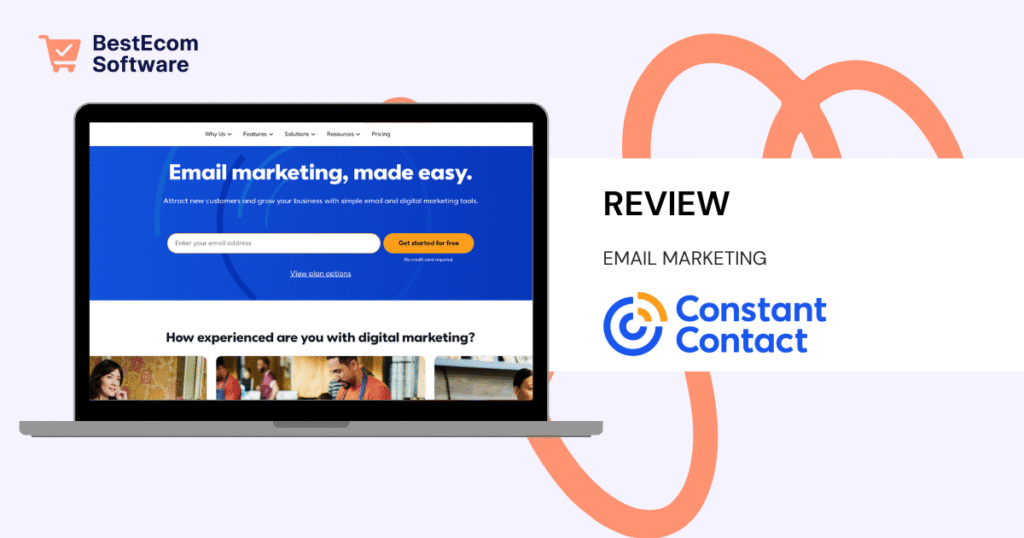
Starting From
- Lite: $12/month for 500 contacts
- Standard: $35/month with SMS, automation, and surveys
- Premium: $80+/month with advanced segmentation & multivariate testing
- Send-Based: From $39 for 10K monthly sends
PROS
- Simple setup with drag-and-drop templates
- Responsive live support channels available
- Extras like event marketing and surveys built in
CONS
- Outdated interface compared to modern tools
- Automation and CRM features are extremely limited
- Steep price hikes with contact growth
Constant Contact Review
Heads up: This Constant Contact review contains affiliate links, which means if you click and buy, I may earn a small commission at no extra cost to you. I only recommend tools I’d pitch to a friend and believe in.
Constant Contact may be a veteran in the email marketing space, but unfortunately, it feels like it. While the platform covers the basics, it hasn’t kept pace with innovation or user expectations. It’s serviceable for the simplest campaigns, but lacks the sophistication and flexibility found in nearly all modern competitors. For those hoping for more than a barebones experience, you might leave disappointed.
Table of Contents
Quick Answers
- What is Constant Contact? An email tool with a dated UI, basic features, and decent support.
- Who’s it for? Small nonprofits or solo marketers who just need to send simple emails—nothing fancy.
- Key features? Email templates, event registration, SMS, and basic list management.
- Compared to alternatives? Easier than Klaviyo, but much less powerful. Feels behind ActiveCampaign or ConvertKit.
- Easy to set up? Yes—but what you’re setting up is a pretty limited toolbox.
- Integrations? Standard options like Shopify, Zapier, and WordPress are covered.
- How much? Plans start at $12/month but get expensive fast as your list grows.
- Pros & cons? ✅ Support is decent; ❌ Features and automation are disappointingly thin.
- Worth it? Maybe for first-timers. Not recommended if you care about robust automation or modern UX.
- Where to get it?
Start your Constant Contact Free Trial →
1. Features & Capabilities
There’s just enough here to send a basic campaign—but that’s about it. The email builder is dated but functional. Templates are drag-and-drop, but design options feel stiff. The built-in automations (like welcome emails and anniversaries) are more checkbox than strategy-driven.
Premium plans claim to offer advanced segmentation and testing, but the logic is shallow and the interface can be frustrating. If you’re coming from anything modern, it’ll feel like a downgrade.
There’s SMS and basic social scheduling—but again, execution is mediocre. Event RSVPs and surveys are decent extras but don’t make up for the platform’s overall simplicity.
If you’re looking to run complex flows, audience segmentation, or ecommerce tracking, look elsewhere.
2. Pricing & Value
Here’s where things get hard to justify. Constant Contact starts low but quickly gets expensive once your list grows past 1,000 contacts. Features are locked behind higher tiers that often don’t feel worth the price bump.
Lite
$12/month
- 500 contacts
- Email & social posting
- Basic automations
Standard
$35/month
- SMS + automation
- Surveys, signup forms
- Reporting & analytics
Premium
$80+/month
- Advanced segmentation
- Event marketing
- Multivariate testing
Send-Based
From $39/month
- 10K sends
- Unlimited contacts
- Overage pricing applies
Even with nonprofit discounts, it feels overpriced for what you get—especially when modern competitors deliver more power at similar or lower price points.
3. Ease of Use & Onboarding
This is one of the few areas where Constant Contact holds up. It’s genuinely easy to get started. Most things work as expected, and you won’t be stuck hunting for buried features.
But that simplicity comes at a cost: the platform often feels underwhelming. Power users will get bored or frustrated quickly.
Good for someone sending their first newsletter. Bad for someone trying to build a serious funnel or integrate with ecommerce deeply.
4. Case Studies & Reputation
Constant Contact has a long history—too long, maybe. Many customer reviews cite ease of use, but also highlight outdated functionality, price creep, and limited flexibility.
Some longtime users have stuck around out of familiarity, but new users often churn once they need more power. Ratings hover around 3.5 to 4.0, which tracks.
Not much has changed over the years. That’s either a pro or a con, depending on how generous you’re feeling.
5. Customer Support & Reliability
The live support is one of the platform’s saving graces. You can call, chat, or attend live onboarding sessions. Help is fast and friendly—something many competitors skip now.
Platform stability is fine, and deliverability is still strong. But none of that makes up for the platform’s lack of innovation or depth.
6. Constant Contact Review Summary & Final Rating
Pros
Cons
Final Rating: ★★★☆☆ (3.4/5)
Constant Contact is fine—but “fine” won’t cut it in 2025. If all you need is a basic email tool and some live support, it’ll do the job. But if you’re looking for serious features, modern automation, or better bang for your buck, there are stronger, smarter choices out there.
